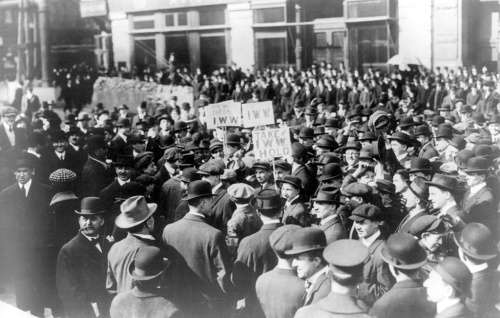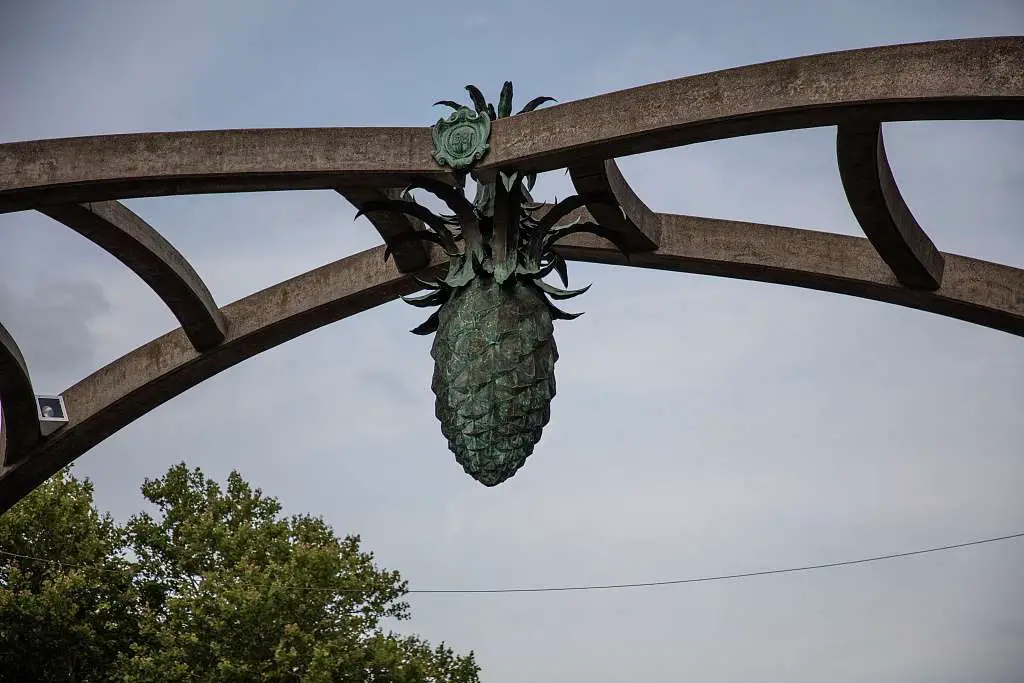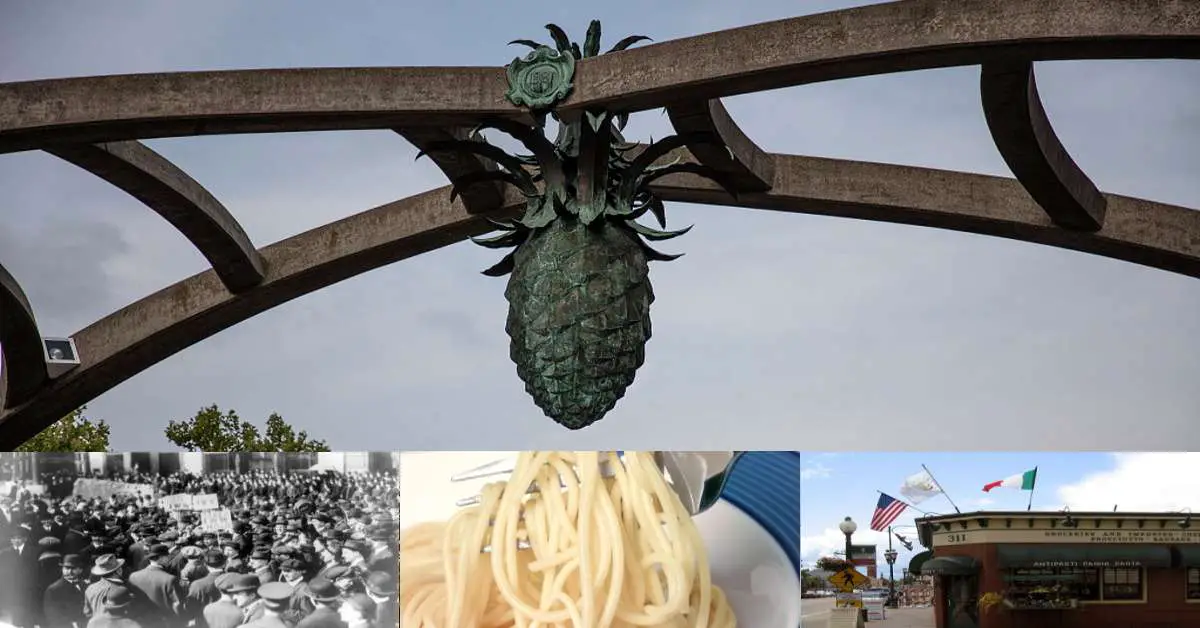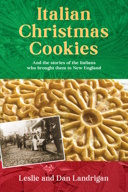The summer of 1914 was a flashpoint for the Italian immigrant families in Providence, R.I. Squeezed on one side by an economic depression, they also began encountering unexpected increases in prices at the markets. Those two forces set the stage for the macaroni riots of 1914.

Pasta made from durum wheat
Providence’s steadily growing Italian population provided tremendous opportunities for merchants with ties to the immigrants’ mother country. English-speaking Irish immigrants had managed to insert themselves into the city’s Yankee-dominated political structure. But Italian and French-Canadian immigrants had less influence on the city’s institutions.
More than 54,000 Italian immigrants arrived in Providence between 1898 and 1932. And that meant a boon to the city’s Federal Hill merchants. The Italian-Americans distrusted American retailers. They did not understand Italian tastes – and many did not want to.

Delivering bread in Providence’s Italian district by Lewis Wicks Hine
Scandalous Pasta
Italian merchants, meanwhile, thrived on the loyal customers they found among their neighbors. Questions about pasta had already been roiling Federal Hill, however. In 1908, F.P. Ventrone had been accused of selling inferior American-made pasta labelled as Italian.
Macaroni Savoia Brand Gragano pasta was produced in Long Island, but labelled to look as if it came from Italy. It was not made with semolina from durum wheat, but dyed yellow to make it appear that it was. The scandal would then play out for years.
Then in 1914, the Italian community experienced a second shock to its kitchens. Pasta prices increased – a lot. The price of this dietary staple skyrocketed by as much as 60 percent. Stores blamed the problem on shortages and price increases caused by World War I in Europe.
The war was an ominous and frequent topic of conversation in the homes of Providence’s Italian families. Some suspected stores played on that fear to raise prices.

Logo of the Industrial Workers of the World, known as Wobblies
Providence’s mayor commissioned a study that found no price gouging. The Labor Advocate newspaper – aligned with the Socialist Industrial Workers of the World labor movement – declared the study a “whitewash.” The newspaper then made a not-so-subtle threat. It predicted the establishment of Frank P. Ventrone would soon “come to an abrupt end so far as Federal Hill is concerned.”
On August 29, protesters began putting action to the words. Italian-Americans had been protesting in prior years over their treatment by the Providence establishment. Encouraged then by the IWW (which figured in the famous 1912 Bread and Roses Strike in Massachusetts), Italians had marched through the streets of Little Italy supporting labor politicians and Italian pride.

An IWW demonstration in New York City in 1914.
The Macaroni Riots
Skirmishes with police were not unheard of at these events, but they were minor compared to the macaroni riots of 1914. On August 29, a rally at the corner of Atwells and Dean Streets turned raucous. The crowd began marching down Atwells Street toward Frank Ventrone’s store.
Ventrone had come to America from Italy in the 1880s and had prospered as the Italian population of the city surged. Dubbed the “Macaroni King,” he imported pasta, produced it and wholesaled it to other groceries. He was the most obvious target for the mob.

La Pigna under the Atwells Avenue arch in Providence’s Little Italy
Rioters smashed Ventrone’s storefront windows. Looters stole pasta and scattered it in the street. As the macaroni riot grew, neighboring stores received similar damage, Pearlman’s Dry Goods, People’s Pharmacy and Cardegna’s barbershop all suffered broken windows.
Police skirmished with the rioters through the next day. Both sides dodged bottles, bricks and bullets.
Frank Ventrone had been vacationing at his summer home in Warwick when the violence broke out. Returning to the city, he tried to explain his side of the story. Retail sellers of pasta were raising prices dramatically, not his company, he said.
Ventrone then met with the leaders of the macaroni riots and agreed to lower his prices. He dropped the cost of a box of pasta to $1.40 from $1.60. And, he promised to make all his pasta available at wholesale prices to any customers who came to his store — not just retailers.

An Italian grocery store on Atwells Avenue today
More Macaroni Riots
The macaroni riots then bubbled over again on September 7. They responded to a Labor Day rally that decried low wages and general inflation. Police, though, had prepared and moved quickly to defuse it.
Fourteen civilians received injuries in the macaroni riots. Ten police officers and firefighters also got hurt. The riots also caused more than $20,000 in damage.
Eventually an economic recovery grew out of the need for American goods in war-torn Europe. Prosperity quelled labor disturbances in New England. And F.P. Ventrone prospered through 1951.
“Italian Christmas Cookies: And the stories of the Italians who brought them to America” is your ticket to a sweet journey through the history, culture and cuisine of Italy and the Italian community in America. Available now in paperback from Amazon. Click here to order.
Thanks to: Every Shout a Cannonball, The I.W.W. and Urban Disorders in Providence, Joseph W. Sullivan. This story about the macaroni riots was updated in 2023.
Images: By I, Infrogmation, CC BY 2.5, https://commons.wikimedia.org/w/index.php?curid=2287338. Pasta made from durum wheat By CSIRO, CC BY 3.0, https://commons.wikimedia.org/w/index.php?curid=35498497.


4 comments
Eileen Becker
Jill Crotty
Thanks for this story 🙂
Please everyone read and sign! STOP THE REROUTING OF RAILROAD THRU BEAUTIFUL SOUTH COUNTY RI/CONNECTICUT!
http://petitions.moveon.org/sign/stop-necfutures-and-the?source=s.fwd&r_by=12570612
Comments are closed.